Trawling for the history of St. Clement’s often feels like embarking on a treasure hunt. When something is unearthed, no matter how small, it’s an exciting discovery. Although historical information about St. Clement’s is sparse, every now and then, a nugget emerges, bringing a sense of triumph and connection to the past.
13/09/2024
Trawling For History: Uncovering St. Clement’s Past
Trawling for the history of St. Clement’s often feels like embarking on a treasure hunt. When something is unearthed, no matter how small, it’s an exciting discovery. Although historical information about St. Clement’s is sparse, every now and then, a nugget emerges, bringing a sense of triumph and connection to the past.
With hope, I reached out to the Anglican Diocese in Wangaratta, wondering if they had any archival information on St. Clement’s. Their response was brief; they confirmed that the church was deconsecrated in 1971 and suggested I contact the Anglican Church in Bright. Fortunately, Mother Moira Evers, the local Anglican reverend, passed my details on to Robyn Hajek, a passionate local historian with a penchant for uncovering hidden stories. Robyn turned out to be an absolute treasure trove of information – a discovery in itself!
The Early Days Of St. Clement’s Land
Robyn’s research revealed that land was gazetted as a temporary reserve for the Church of England in 1870. Back then, Eurobin was known as Black Springs, and the reserve was intended for a church and a minister’s dwelling. A Victorian Railway Department map from 1877 even shows the church land in the bottom left quarter. It’s a thrill to see this piece of history marked out, knowing that St. Clement’s still stands on this very spot today.
She also uncovered a Barwidgee map from 1881, further confirming the Church of England reserved land on George A. Gordon’s property. This discovery was satisfying, like finding that final puzzle piece that completes the picture of Eurobin’s spiritual beginnings.
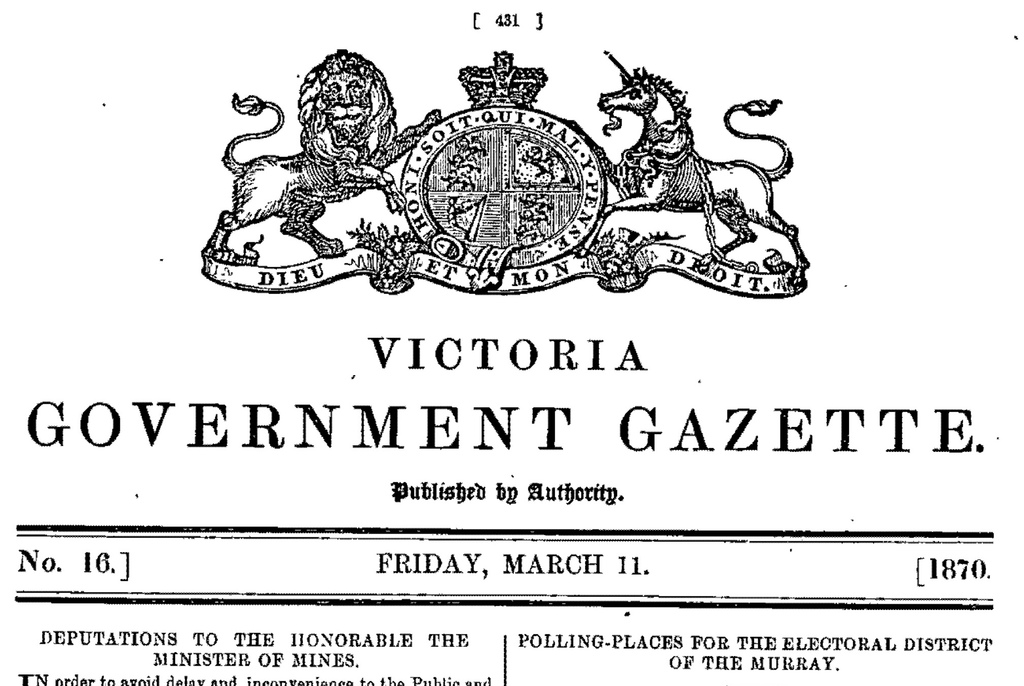
A chain and a link are both old units of measurement traditionally used in surveying and land measurement, especially in the British Empire and its former colonies like Australia and the United States. 1 chain = 66 feet = 22 yards = 100 links. There are 80 chains in a mile (so 10 chains = 1/8 mile). A surveyor’s chain was a physical chain made of 100 metal links, with each link measuring 7.92 inches. Surveyors would physically carry and stretch this chain across land to measure distances.
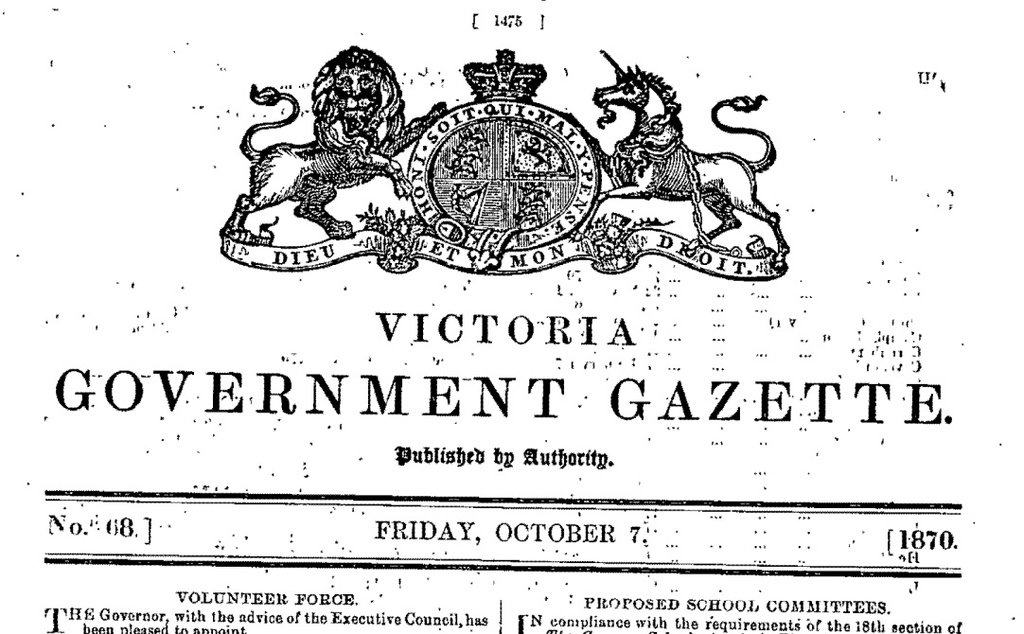
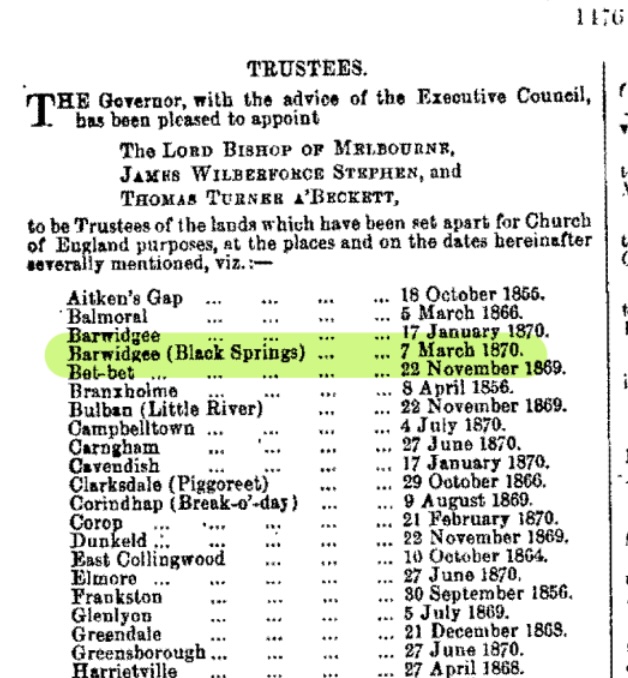
A Victorian Railway Department map from 1877. The church land (where St Clement’s still stands today) can be seen in the bottom left quarter, on G. Gordon’s land.
A Barwidgee map from 1881.
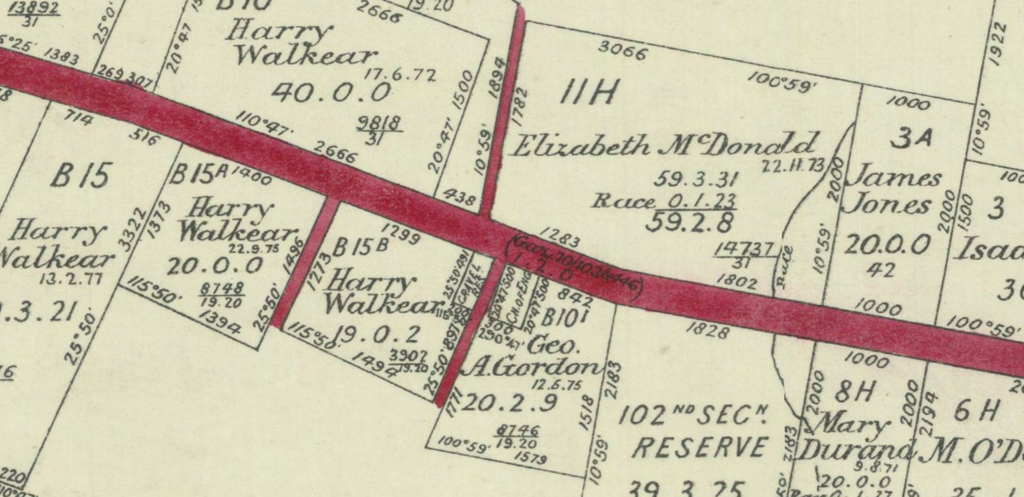
A close-up of the 1881 Barwidgee map focussing on the relevant part of Eurobin. On George A. Gordon’s property, in the top left, is the Church of England land, where St Clement’s Church was to be built. It is next door to the property of Harry Walkear, as stipulated in the Victorian Government Gazette of 11th March 1870.
Yet, the story wasn’t entirely clear. To piece it all together, Robyn suggested I undertake a Title History Search, which unearthed yet another crucial fact: the land, originally reserved in 1870, wasn’t officially transferred to the Diocese of Wangaratta until 1980 – 110 years later! It seems bureaucracy moves slowly, but for the people of Eurobin, their church was already an essential part of the community long before the legalities caught up.
Eurobin’s Spiritual Journey: Early Services
Long before St Clement’s church was built, church services were already a regular part of Eurobin life. First, the priest stationed in Bright would travel to the surrounding villages, including Rosewhite, Mudgegonga, Waterloo (later known as Barwidgee Creek), and Palmerston (now Gapsted), bringing faith to these scattered communities. At some point, believed to be soon after 1897, Myrtleford priests took on the rotation.
Robyn’s research turned up church service records dating as far back as 1894. While it’s not certain where these early services took place, it’s likely they were held in a community hall or perhaps even someone’s barn. During one of my own investigations on Trove, I discovered a charming article describing a wedding that took place on 29th December 1897. The article described a tastefully decorated church, but the mention of an “impromptu altar and carpeted floor” suggests that it was a temporary setup – perhaps a makeshift church before St. Clement’s was built.
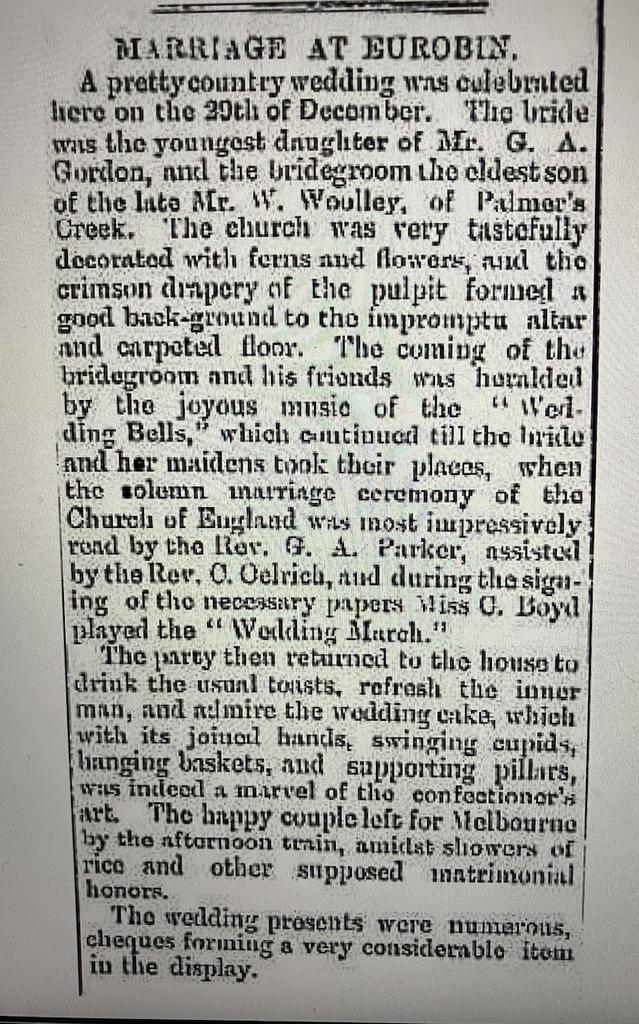
(News article from Ovens and Murray Advertiser 16/1/1897)
In Eurobin, almost opposite the railway station site, a Historical Site Marker sign points to the location of the old Eurobin school (State School number 1355). The site’s information board notes that on 1st January 1874, Eurobin School opened as a leased State School “in the church building” (much like the school/church arrangement in Little House on the Prairie’s Walnut Grove, but in reverse!), paying a rent of £10 per annum. This continued until August of the same year when a new building was dedicated to the school purpose.

Old Eurobin school (1355) site, marked by “Historical Marker” sign, near Eurobin Station, Great Alpine Road, Eurobin. The sign was erected by the late Alf W. Richardson, who lived in the white weatherboard house next door. The information on the sign was taken from a text called “Vision and Realisation: A Centenary History of State Education in Victoria” (Leslie James Blake, 1973). (Grateful thanks to Myrtleford & District Historical Society for the information).
The earliest known physical record of Anglican church services in Eurobin (1894)
(Thanks to Alpine Anglican Parish)
Robyn had access to historic service registers – precious documents that detail the service notes made by priests over the years, going right back to 1894 and later, covering the period relevant to our research on St. Clement’s. These registers are a real treasure, filled with handwritten notes by the attending priests about the services they conducted and little details they found worth mentioning. By 1910, Eurobin was part of the Myrtleford Parish of the Church of England.
Reverend Leslie Watt: The Man Behind The Mission
The first relevant entry from 1910 reveals the priest as “Jas. L. Watt.” In the late 1800s and early 1900s, men’s names were often abbreviated for brevity in written records. “Jas.” was short for James, while “L.” stood for Leslie. From the records, it’s clear that Reverend James Leslie Watt was never idle on Sundays. He often conducted three services in a single day, travelling by horse from Mudgegonga for a morning service, to Waterloo in the afternoon, and ending the day with an evening sermon in Myrtleford. Without modern transport, these must have been long and tiring days.
Rev. Watt’s registers are meticulously kept, recording small details that bring the past to life – important events, weather conditions, and attendance figures. The occasional ink blot on the pages serves as a reminder of the imperfections of writing at the time. Myrtleford’s evening services seemed to be a highlight, with congregations sometimes reaching up to 70 people.
In contrast, Rev. Watt’s journey to Buffalo River on 16th January 1910 must have been disheartening, as only three people attended. It appears that at least four were required to officially hold a service. Yet, despite these challenges, Rev. Watt remained undeterred, continuing his duties with the same quiet perseverance.
Rev. Leslie Watt was described as a “quiet, sincere, Christian man, whose ability lay principally in his organisational ability. Every task he undertook was carried out with characteristic thoroughness…”
(Photograph of Canon James Leslie Watt from “The Mission Journal” with thanks to The Anglican Diocese of Melbourne archivist.)
A more sombre entry on 30th January records the death of Mr H. Walkear in Eurobin. A local news article sheds light on the tragedy: Mr Harry Walkear, a well-known and respected farmer, was found dead beside the road after returning from Bright. It was believed that he leaned forward to retrieve a falling bag from his gig, lost balance, and tragically suffered a fatal fracture to the base of his skull. This is the same Harry Walkear mentioned in the Gazette (above) and whose name may be seen on the Barwidgee map (above).
The personal touches in these registers – ink blots, attendance notes, the weather and even reports of community tragedies – give a remarkable glimpse into the life of the parish at that time. The most significant entry on this page, however, is found in the bottom right-hand corner, dated 6th February 1910: “New church started Eurobin.” This brief yet monumental note marks the beginning of St. Clement’s Church. It was on this day that the foundation for what would become a key part of Eurobin’s spiritual and communal life was laid. What a remarkable moment to witness through the words of the priest who was there from the very start!
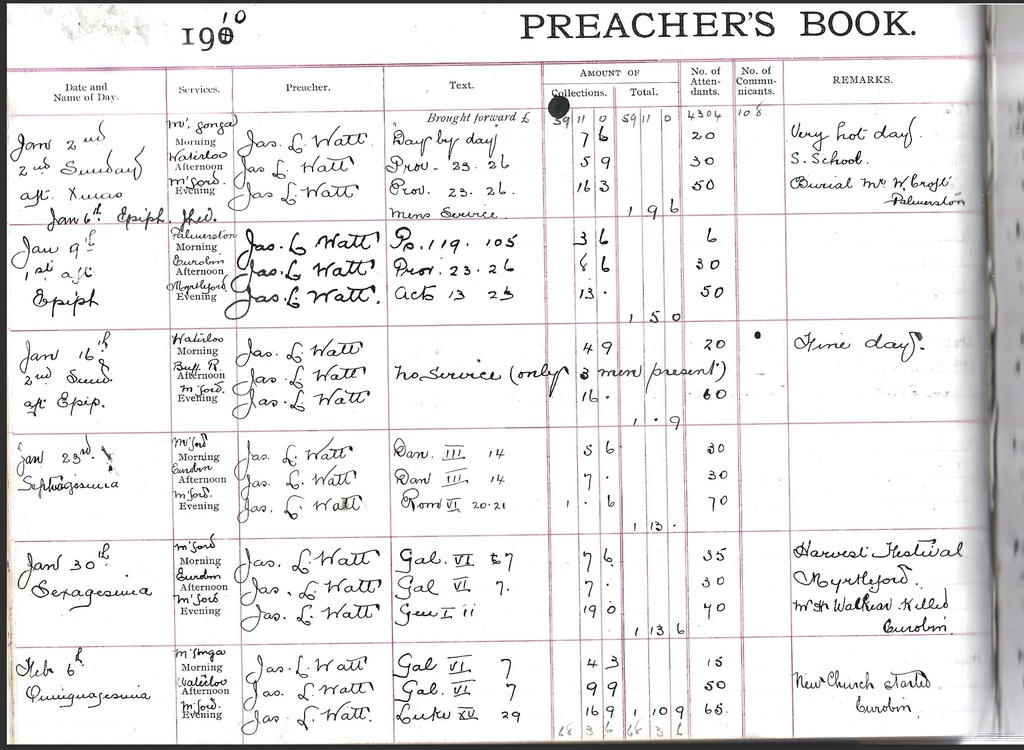
(Courtesy of Alpine Anglican Parish)
Robyn discovered a record for St. Clement’s on the Public Record Office of Victoria website. After applying, I soon received the file, which contained several documents, including plan submissions and correspondence from Rev. Leslie Watt to the Board of Public Health in Melbourne regarding the church’s construction. In a letter dated 25th February 1910, the Reverend expressed his desire to open the church on 11th March 1910 (he wasn’t leaving much time for a response!):
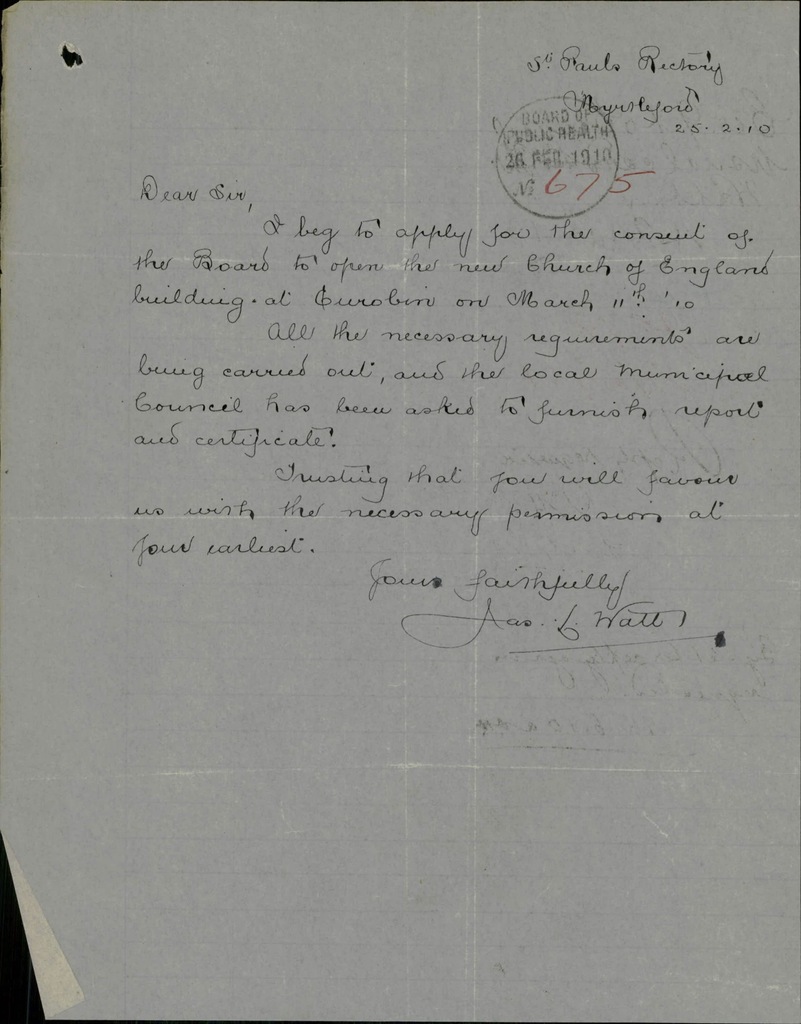
While no reply from the Board of Public Health appears on file, the church did indeed open on the intended date. Bishop Armstrong dedicated St. Clement’s on 11th March 1910, and the first service took place two days later on Sunday, 13th March 1910.
Preacher’s Register of Services showing St Clement’s dedication and first service – 13th March 1910.
(Courtesy of Alpine Anglican Parish)
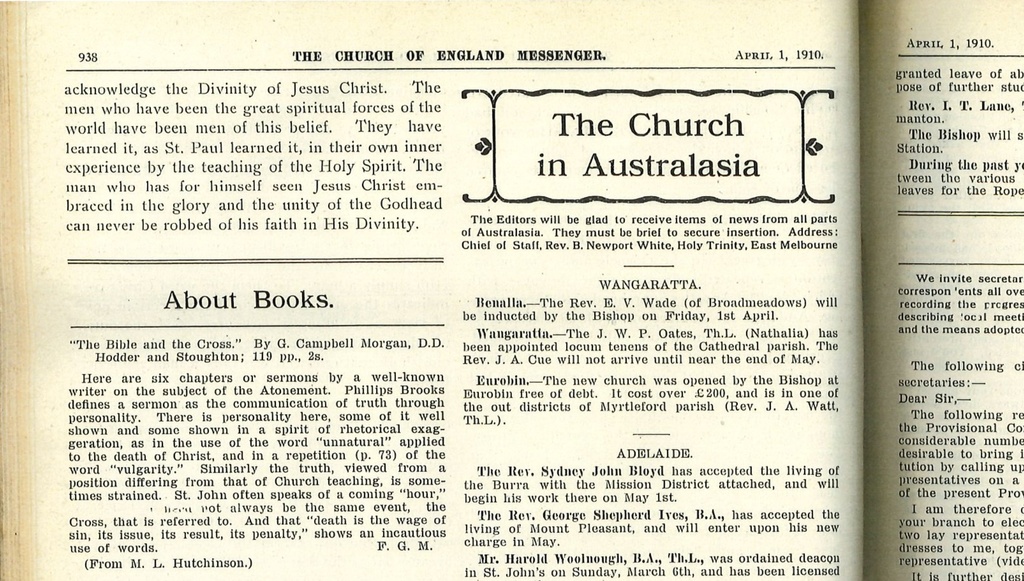
The opening of the new church.
(The Church of England Messenger, 1/4/1910, Courtesy of Anglican Diocese of Melbourne archivist)
The following article from the Ovens and Murray Advertiser mentions the pride of the Eurobin people in the erection of their church. It also includes an excerpt from the “eloquent sermon” delivered by Bishop Armstrong, quoting Genesis 28:17:
“How awesome is this place! This is none other than the house of God; this is the gate of heaven.“
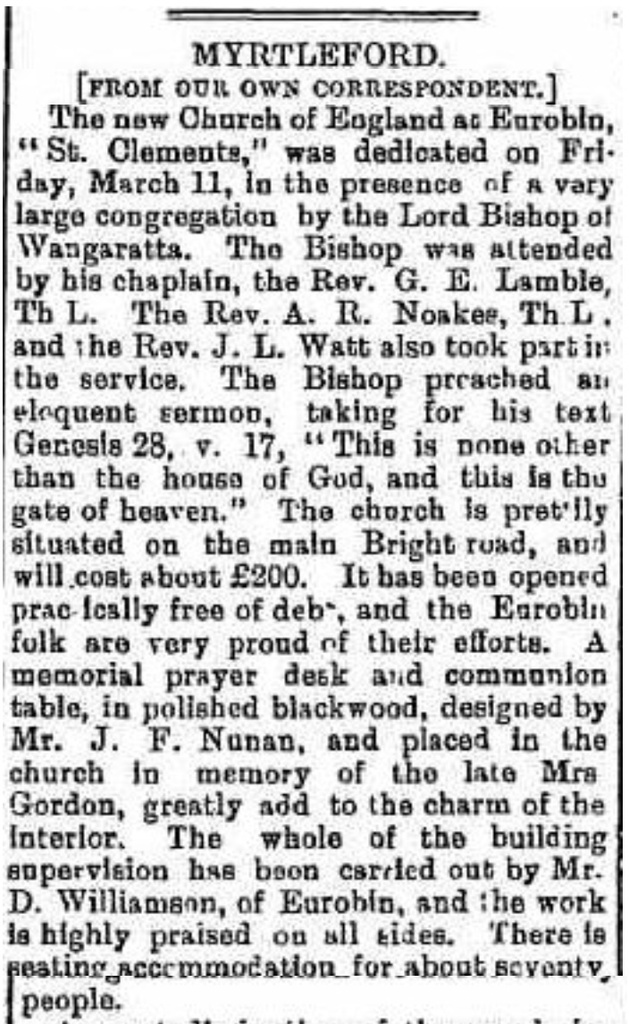
(Article from the Ovens and Murray Advertiser 19/3/1910 (page 3))
Bishop Thomas Henry Armstrong (1857 – 1930) was described as “energetic, cheerful and sympathetic”. Standing at an impressive 6’3”, with striking red hair and a beard, he was known for his presence. He carried a walking stick that was uniquely wrapped in tiger snake skin, marking each snake he killed with a notch. An enthusiast of shooting, fishing, and gardening, his strong qualities and connections endeared him to the local rural community
(The Advocate, Autumn 2022 (page 5)).
St. Clement’s First Wedding And Hasty Completion
Perhaps one of the reasons for the church’s hasty completion was the impending wedding of Annie Greer and Mark Lowerson, who were married at St. Clement’s just two days after its dedication. Mark, incidentally, had been part of the team that built the church. According to Annie’s obituary, Mark had worked with a group until nightfall on the eve of their wedding, putting the finishing touches on the church to ensure it was ready for their big day.
This story adds a layer of charm and urgency to the construction timeline. One can almost picture the hustle and bustle of the final hours as Mark and his team made sure everything was perfect for the ceremony.
Extract from article “Obituary – Mrs Annie Jane Lowerson”
from Myrtleford Times and Ovens Valley Advertiser 26/8/1942 (page 2)
Complications With The Board Of Health
Despite the church being in full use, there was one small catch – the Board of Health hadn’t given its official approval! In fact, approval wasn’t granted until 16th November 1910, a full eight months after the church was opened. A health inspection in July revealed that the oil light fittings were too low (they were required to be at least 6’8” above the floor but were measured at just 5’6”), and there was no step provided at “Doorway B” (the entrance facing Bright), sparking a flurry of correspondence between the church and the authorities.
An extract from the plans submitted to The Board of Public Health in Melbourne. The chancel, nave and porch are included but the vestry was not. It must have been added at a later date as presumably the church would not have passed the Board’s inspection if it were added without being included in the plans
(Extract from Public Records Office of Victoria archived file).
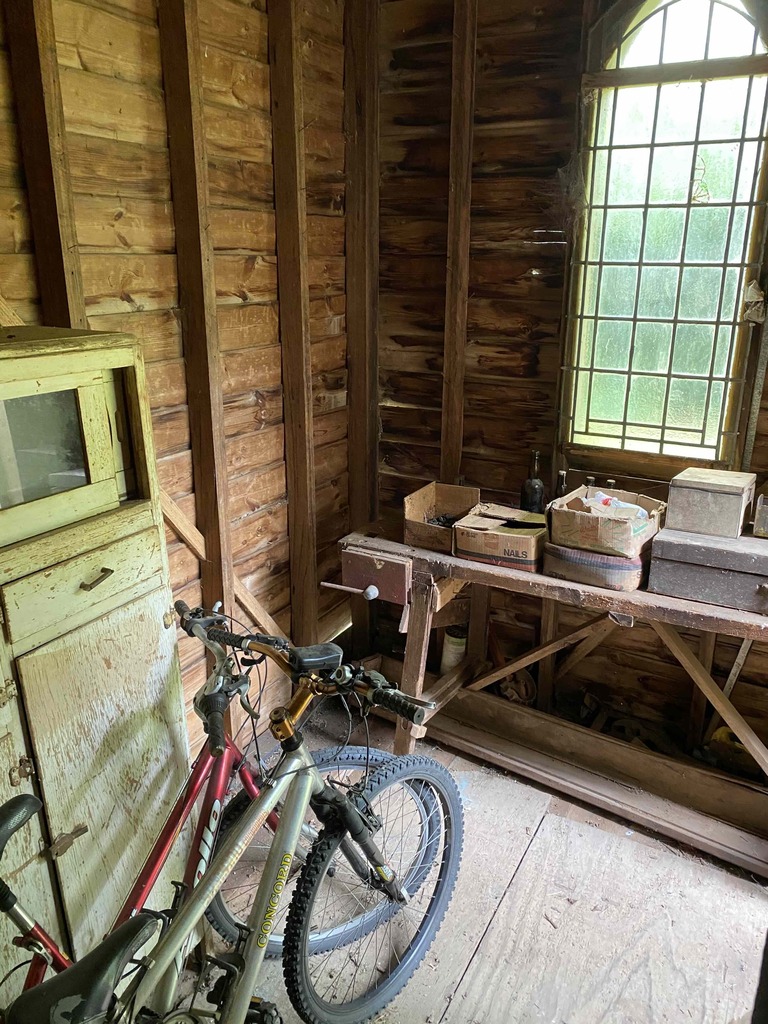
The vestry was never completed to the same high standard as the church main building – perhaps something of an afterthought. This photo shows how rough the walls and floor were. The window glass here does not match the rest of the church. It has a recycled window from elsewhere which has been fastened to the window space (Photo from my own collection).

(Extract from archived file of the Public Records Office of Victoria)
It’s amusing to think of the rush to build and dedicate the church, only to have the official stamp of approval lagging far behind. Whether the rush was due to a sense of competition with St. John’s Presbyterian Church down the road or simply the excitement of the Lowerson-Greer wedding, one thing is certain – St. Clement’s was built with urgency and pride.
A Lasting Legacy
Incredibly, while St. Clement’s took just 34 days to build, it has stood strong for over 41,821 days. What began as a rushed weatherboard construction with a tin roof has far outlasted its hasty origins, becoming the only community building still standing in Eurobin. Over more than a century, this small church has endured, weathering the passage of time as a steadfast symbol of faith, community, and resilience.
The fact that it was constructed in little over a month, yet has remained for nearly 115 years, speaks volumes. St. Clement’s is far more than just timber and tin; it is a testament to the dedication and love of the people who built it, their legacy echoing through every one of the 41,821 days since its completion.
Help Uncover St. Clement’s Hidden History
If you have ancestors from the Eurobin area or family ties to the region, I encourage you to take a look through any old photo albums or collections that may have been passed down. Historic photos of St. Clement’s Church are so rare (there is only one known), and any images – no matter how small or faded – could provide valuable insights into its past. Your family’s forgotten treasures might just hold a piece of the church’s rich history, and I’d love to hear from anyone who may have such photographs or memories to share!
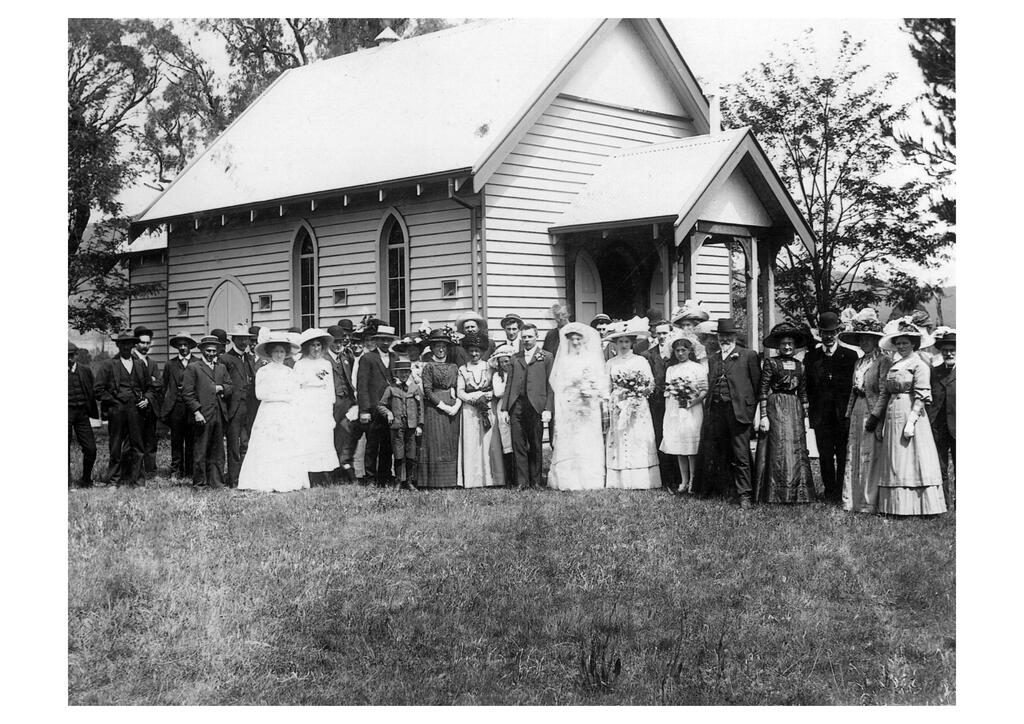
The only known historical photograph of St Clement’s: The Walkear / McDonald wedding on 24th October 1911.(Photograph courtesy of Myrtleford & District Historical Society)
Comments +